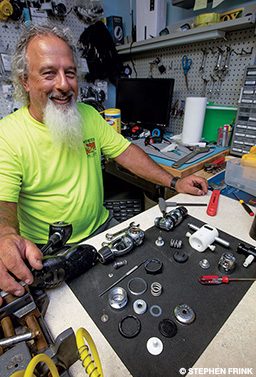First-stage scuba regulators convert high pressure to intermediate pressure and must deliver gas at a constant intermediate pressure, relative to depth, to the second stage for divers to breathe easily. To maintain constant delivery despite changes in water conditions, depth, breathing needs and pressure in a scuba cylinder, first stages have a sensing mechanism that adjusts to these changes, allowing for constant pressure and delivery regardless of the conditions.
There are two main ways for these devices to respond to changes in supply pressure, demand and depth in real time. Diaphragm-sensed regulators use a flexible element to adjust to these changes and to ensure constant outlet pressure and flow relative to depth; piston-sensed regulators use a sliding metallic piston that moves to adapt to these variations.
Some divers think that piston regulators are lighter, smaller, and more reliable, robust and sensitive to changes. Some believe they perform better at depth, accommodate greater gas flow, function more reliably in freezing conditions and are cheaper to maintain despite initially being more expensive. Those who prefer piston regulators claim they are a better value for their money than any diaphragm product.
Other divers swear by diaphragm regulators, finding them to be superior in terms of all the above-stated advantages. Traditionally, diaphragm regulators are sealed from the environment to reduce the likelihood of any internal corrosion or freezing in cold water.

The truth is that modern, good-quality regulators are designed, machined and built so well that the limitations and bad experiences of the past are no longer the reality. Personal preference, rather than operational capacity, now governs divers’ decisions. The average diver would likely be unable to discern a difference in performance between the two types of regulators in most types of diving. If your regulator type suits you, then stay with it. If you are purchasing a new regulator, you may want to consider how you will be using it before making your final decision.
Think about what kinds of diving you intend to do, ask questions, and research recommendations based on your intended activities. Try several regulators if you can, and then get the one that performs best for you. For 90 percent of diving activities, the regulator type does not matter. If you will occasionally be diving where a specific regulator type may be advised based on the environment, then you can always rent something more suitable for those specific conditions.
For example, strenuous diving at depths below 300 feet may raise concerns about gas flow. Inquire about a regulator’s performance being able to meet the maximum demand without affecting ease of breathing. Similarly, if you dive where surface temperatures are freezing, choose a regulator rated to perform at those surface and underwater temperatures without seizing up.
Divers who migrate from air to gas mixtures, especially with oxygen varying from hypoxic levels to pure oxygen, should select a regulator that is compatible and safe for use with elevated oxygen levels. Check for this certification and rating with the dealer or manufacturer.
Regardless of which type of first stage you choose, follow the manufacturer’s guidelines for use and maintenance. Failing to follow the manufacturer’s requirements to regularly service the regulator or using spare parts not provided or approved by the manufacturer will void any warranties or certifications. Such negligence could be a contributing factor to a regulator failure, regardless of type.
Some divers use compressed gas to blow off the inlet to the regulator after the dive or after rinsing the regulator. Doing that will simply blow water and any other debris into the regulator and may make the seat fair game for damage, corrosion and potential leaking or seizing, regardless of the regulator type. To prolong the life of your regulator, use a microfiber towel to clean the regulator inlet and the dust cap, which ensures optimal reliability and preserves your regulator (along with the hearing of those around you).
Regulator reliability and lifespan are almost entirely dependent on human elements such as proper use and maintenance, not regulator design or configuration. When purchasing a new first stage, do not base your decision on whether it has a piston or a diaphragm. Choose the one you like that is the best suited for your preferred type of diving, and follow the manufacturer’s recommendations for care and service.
© Alert Diver — Q3 Summer 2019